Automation Testing: Pros and Cons
When to Implement Automation Testing
When to Opt for Manual Testing
At the beginning of each project, as the Head of QA at HQSoftware, I assess project requirements to help a client to make an informed decision whether to prioritize automated testing during the project.
Throughout the project, I evaluate the testing process and adjust the testing strategy, balancing the manual testing vs automation testing process. To do this efficiently, I consider the capabilities of both options and use a custom calculator to estimate automation ROI (return on investment).
I’ve prepared two examples to illustrate how I use the calculator and which metrics I choose for it. I’ll also share my practical insights on choosing the right type of testing to craft an efficient testing strategy.
Automation Testing: Pros and Cons
When to Implement Automation Testing
When to Opt for Manual Testing
Automation testing involves executing pre-scripted tests on a software application using automated tools. It involves writing scripts and using specialized software tools to automate repetitive tasks.
Automation testing offers:
However, this approach also has drawbacks:
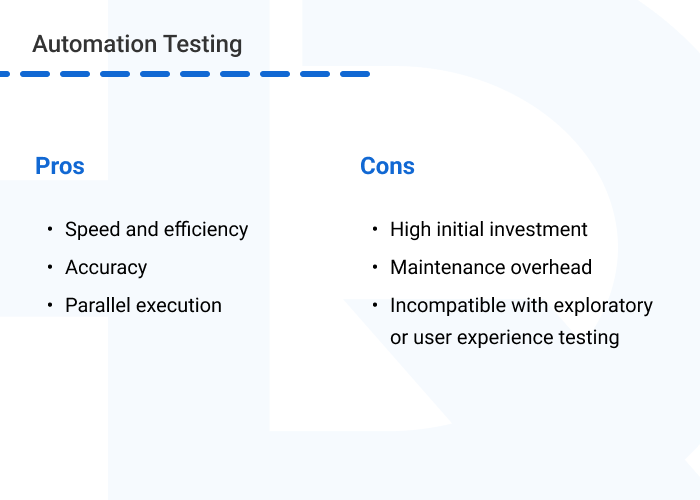
Automation testing may not be suitable for all types of testing scenarios, which is why this question arises: manual testing vs automation testing. So let’s take a look at manual testing principles.
Manual testing involves the execution of test cases by humans without automated tools. Testers interact directly with the software application, observing its behavior and identifying any defects or anomalies.
Manual testing excels in scenarios where human intuition and creativity play a crucial role. This is particularly evident in exploratory testing, where testers can uncover unforeseen issues and provide valuable insights into the software’s usability and user experience.
Manual testing is especially valuable for small projects with a tight budget. It eliminates the initial investment required for automation setup, making the approach more cost-effective.
However, manual testing tends to be slower, potentially causing delays in larger projects, because of the time required for manual execution and validation of test cases. Human error is also possible in manual testing, affecting the reliability of testing results.
Moreover, scaling manual testing for large and complex projects can be impractical, limiting the suitability of this approach for extensive software testing efforts.
Based on my experience, automation testing can be more effective in the following cases:
However, there are some cases in which manual testing is more profitable.
While choosing manual vs automation testing, you should opt for manual when the situation involves a:
However, these factors don’t provide the ultimate answer to this question, as each project is unique and should be considered on its own merits. That’s why, when I make a decision about automation vs manual testing, I always calculate automation ROI.
Automation ROI, or return on investment, measures the benefits of implementing test automation in terms of time and financial costs. It’s essential to calculate automation ROI to understand the efficacy and cost-efficiency of automation compared to manual testing.
To calculate automation ROI, you’ll need to account for the following factors:
Based on the factors mentioned above, we can calculate:
Now, let’s dive into two examples, in which I show how I calculate automation ROI and decide which type of testing will be more profitable, based on project details.
Note that all numbers are approximate and costs are provided as an example.
Project duration: 6 months.
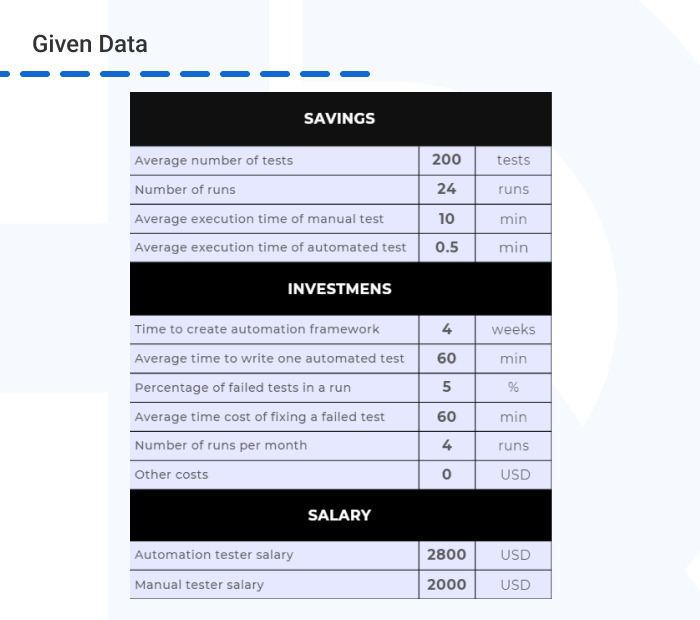
Let’s calculate the results.
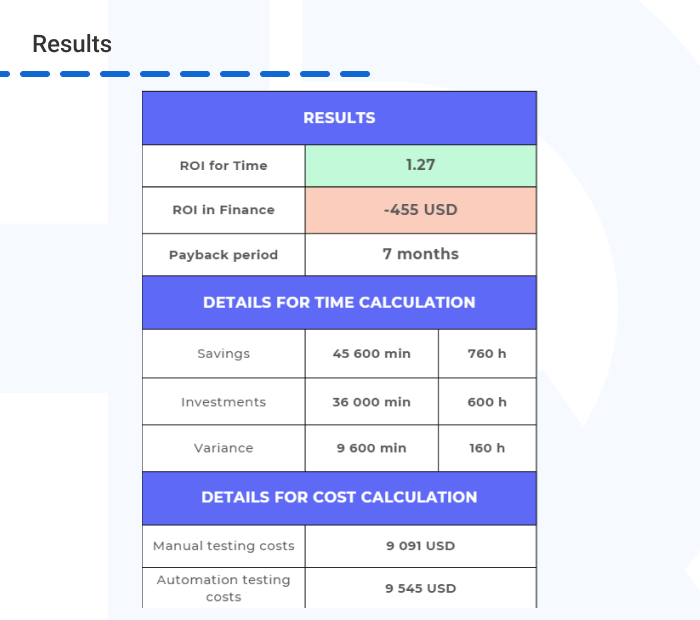
When will our investment start paying off? Let’s calculate the payback period.
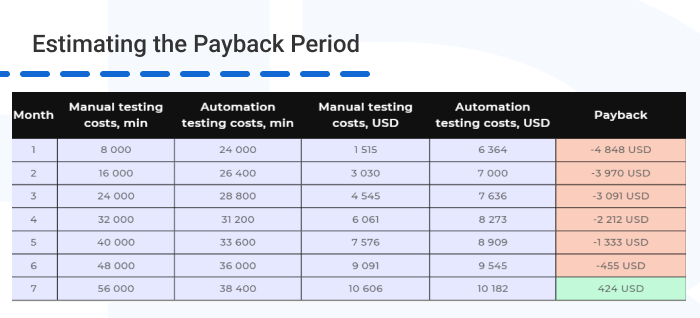
Results:
In this scenario, the automation testing doesn’t show positive financial benefits but does exhibit positive time benefits.
In this example, let’s double the project duration while keeping other variables to see if automated testing would be profitable in this case.
Project duration: 12 months.
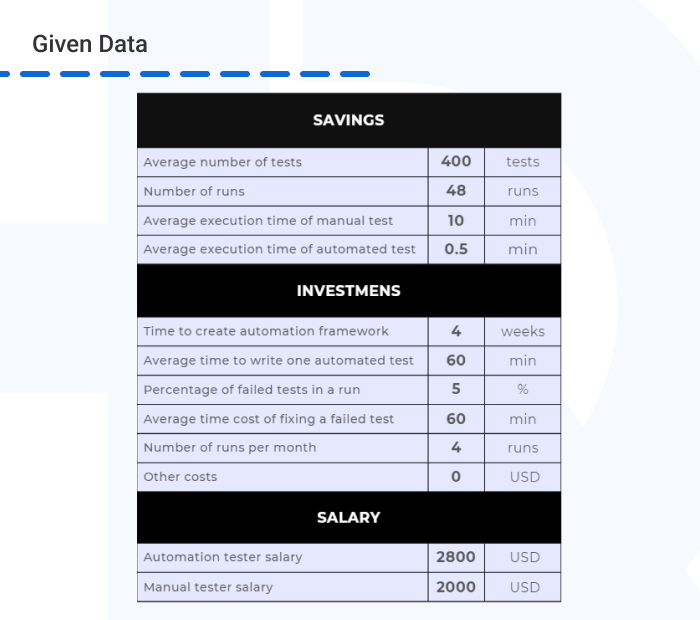
What results will we get?

And let’s estimate the payback period.
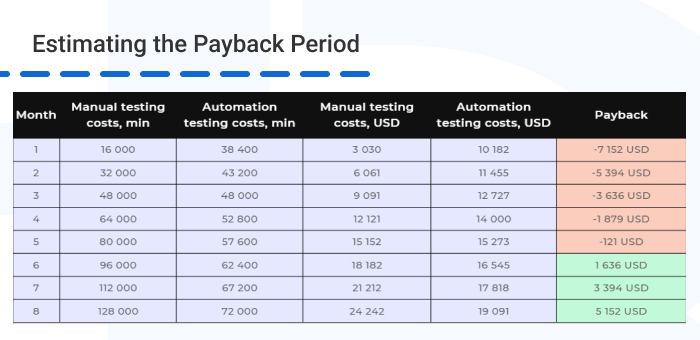
Results:
In the case of increased project duration, automation proves really beneficial.
It’s important to note that these calculations are approximate and each project should be calculated individually.
Can’t choose a testing stategy? We’re ready to help!HQSoftware has a team of skilled professionals ready to tackle the your task. Ask me!
Anna Halias
Business Development Manager
Beyond factors that are needed for calculation, some other factors can also influence your choice of testing type and should be considered additionally:
Consideration of these additional factors alongside the ROI calculation can provide a more comprehensive understanding of the optimal testing strategy for your project.
Summing up, I also would like to note that:
While both testing approaches have their advantages, you don’t necessarily need to choose manual vs automated software testing. A strategic blend of them can optimize testing efforts, helping you receive high-quality software.
At HQSoftware, we offer guidance to making informed testing strategies and streamlining testing processes. Contact us to learn more about how we can boost your product quality and save resources with the right testing approach.

Head of Quality Assurance
Specialist with 7+ experience in defining, establishing, and auditing test processes and approaches for web and mobile projects. Help build better products that people and businesses love to use.
We are open to seeing your business needs and determining the best solution. Complete this form, and receive a free personalized proposal from your dedicated manager.

Sergei Vardomatski
Founder